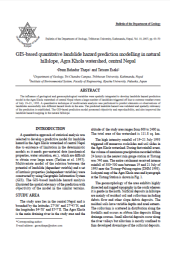GIS-Based Quantitative Landslide Hazard Prediction Modelling in Natural Hillslope, Agra Khola Watershed, Central Nepal
Summary
In the Agra Khola watershed of central Nepal, a landslide hazard prediction model was developed by spatially integrating geological and geomorphological variables. This region experienced a significant number of landslides during the extreme weather event of July 19–21, 1993. The study employed a quantitative technique of multivariate analysis to successfully predict landslide occurrences at different hazard levels. The validity of the predicted landslide hazard was confirmed, establishing the spatial relevance of the model. The GIS-based prediction model demonstrated objectivity and reproducibility, enhancing landslide hazard mapping in natural hillslopes. Given the limitations of deterministic models requiring extensive geo-material data, a quantitative statistical analysis approach was chosen for developing the predictive model. The multivariate model, utilizing GIS, illustrated the relationship between landslide potential (dependent variable) and intrinsic properties (independent variables), providing valuable insights into landslide hazard analysis in similar terrains with spatial relevance and objectivity.
Categories:
Article
Publisher:
Department of Geology, TU
Published Year:
2007
